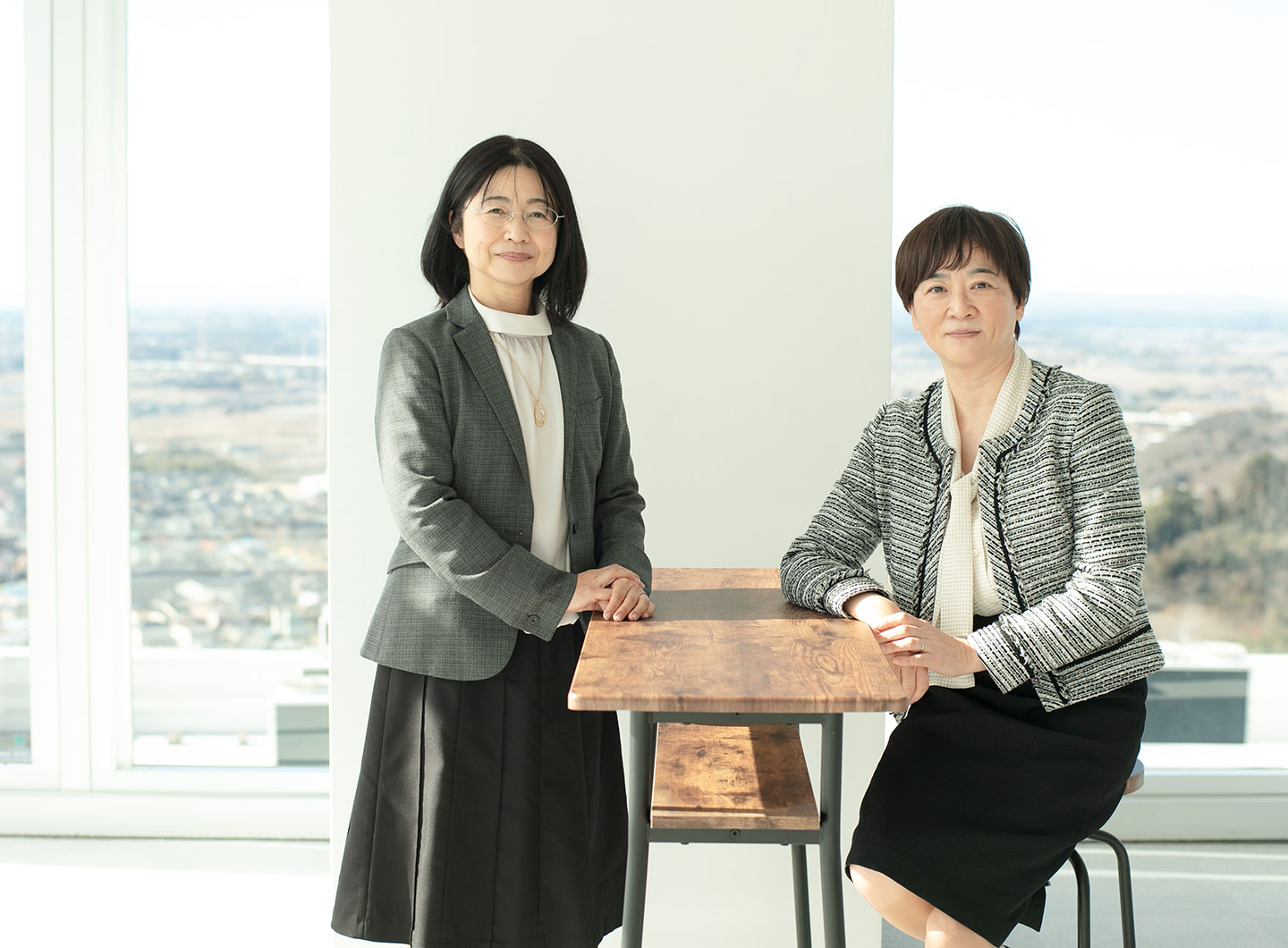
Radiotherapy, one of the three leading treatment options for cancer alongside surgery and chemotherapy, kills cancer cells by irradiating them to damage their DNA. Unlike surgery, it features the ability to better preserve the affected organs and ease the burden on the patient's body. Currently, depending on the objective, cancer type, and stage, a diverse array of radiotherapeutic approaches comprising different types of radiation and irradiation technologies are used. They include treatment approaches such as radical therapy to cure cancer in its early stages, treatments for advanced metastatic cancer, palliative therapy aimed at alleviating the pain from metastatic bone disease, and radiotherapy combined with chemotherapy (chemoradiotherapy). It is anticipated that radiotherapy will make continued strides in the years ahead. We interviewed Senior Project Manager Liping Shen, who leads a project team, as well as Distinguished researcher Yuko Kani, both with the Energy Innovation Center for Decarbonization, for their views on the current state of and future outlook for R&D of higher-precision, easy-to-use radiotherapy.
(Feb. 27, 2023 release)
The radiation utilized in radiotherapy to treat solid tumors can be divided into two types. Short-wavelength X-rays and gamma rays, which are forms of electromagnetic radiation, as are electric waves and light, count as one type. X-rays and gamma rays possess high permeability and feature the ability to penetrate skin and muscle tissues. However, they cannot pass through lead, which is why the examination rooms in facilities for X-ray diagnostics are typically lined with lead shielding.
The second type comprises beams of accelerated particles, namely electrons, protons, neutrons, among others. The permeability of these particle beams changes with their energy level, and they deliver maximum doses of radiation to the point where they stop. Consequently, the intensity of the radiation dose can be increased by projecting the beam onto the target lesion by controlling its energy with adjustments for the shape of the lesion and its depth from the body surface. One advantage of particle beams is that they do not exit the body after irradiation. However, accelerating these particles requires a large accelerator. Our team is developing a (high-energy) high dose rate accelerator that will be smaller in scale than other devices for particle beam therapy. In graduate school, I earned my doctorate with research on sensors that exploit magnetic materials, and that background has tied in with my current research on the magnetic poles used in accelerators.
Accelerating particles requires long distances. In an accelerator, charged particles are accelerated by circulating in an eccentric trajectory deflected with a powerful magnetic field. Further, there are two types of accelerators: synchrotrons that accelerate the particles by changing the magnetic field along the same orbit, and cyclotrons that accelerate particles outwards along a spiral path under a static magnetic field. Synchrotrons can produce particle beams of a desired energy level with easy on/off control, but irradiation is intermittent, and miniature versions (with diameters of about 7 m) are challenging to build. In contrast, cyclotrons produce beams that can be utilized for continuous irradiation, and because a static magnetic field is used, small-scale versions (with diameters of about 3 m) can be more readily built by incorporating superconducting electromagnets. However, as cyclotrons only produce beams at maximum energy, regulating that energy with external attenuators is necessary. With our project, the goal is to harness original Hitachi technology and develop a novel accelerator that incorporates the desirable features: adjustable beam energy, small size, and sequential irradiation.

"Shen is a researcher with a broad vision and wealth of experience, both at our headquarters and overseas. Her approach to research is an inspiration. I want to emulate her ability to clearly articulate her observations." (Kani)
A key feature of this new accelerator is its ability to place particle beams on an eccentric trajectory. It can accelerate beams to a target energy level internally and emit rays of a desired energy using an emitter. In our research to date, we have already confirmed through simulations that the accelerator is capable of emitting beams within the range of energies required. Now, we are preparing to test whether the technology can produce low- and high-energy beams by adjusting the distribution of the magnetic field.
Treatment throughput can be improved and side effects reduced if the beam dose rate and energy can be controlled according to the cancer status and position of the target for irradiation and beams of the required energy level can be continuously irradiated. Once this system is perfected, I think it will be easier not only for the leading hospitals but also for mid-tier hospitals at the regional level to adopt it and, as a result, it will be able to provide more cancer patients with access to more advanced care.

I majored in chemistry at university and conducted basic research on medical drugs, particularly nuclides* for diagnostic agents. After joining Hitachi, I was assigned to a unit engaged in energy-related development work, where I became involved in research on technologies for the recycling of spent nuclear fuels and the processing of contaminated wastewater from the Fukushima Daiichi nuclear power station. And now, I've returned to research on nuclides for medical use.
* A nuclide is a type of atom defined by the makeup of its nucleus (numbers of protons and neutrons and energy state of the nucleus).
In addition to methods like particle therapy used to irradiate lesions directly with radioactive beams, Hitachi is also engaged in R&D on the targeted radionuclide therapy combining the administration of drugs that selectively accumulate in cancer cells with radioactive substances that destroy cancer cells. This therapy treats cancers that spread throughout the body, such as metastatic solid tumors, leukemia, and lymphoma.
Our team is currently investigating ways to produce actinium-225 (Ac-225). This radionuclide emits alpha particles that can destroy cancer cells. Targeted alpha particle therapy is a relatively new form of radiotherapy. In 2016, it was reported that this therapy with a radiopharmaceutical containing Ac-225 was used to treat a patient with advanced metastatic prostate cancer, achieving almost complete remission. The effectiveness of this treatment has drawn significant attention.
One advantage of alpha particles is that they deliver their energy only to the immediate vicinity of cancer cells and thus do not readily impact normal cells surrounding the lesion. Therefore, hospitals and other facilities that offer this therapy do not need to install special shielding. Further, Ac-225 has a relatively long half-life of approximately 10 days; in terms of the duration of post-production transport and preparations for its use in medical settings, it can be described as a relatively easy-to-handle nuclide.
Natural actinium is present in uranium ore, but only in minuscule amounts. Moreover, it is not a type of nuclide with properties suitable for medical use. Therefore, it is impractical to extract and use actinium in its naturally occurring form. Currently, Ac-225 is produced in small amounts from thorium-229, a nuclear material that is also difficult to handle. Researchers are also exploring the idea of harnessing nuclear reactions in atomic reactors or accelerators to produce Ac-225, but thus far, global demand has far outstripped supply. Another problem is that impurities which could be contained in the Ac-225 produced for therapeutic use can cause side effects. An efficient technique to mass-produce high-quality Ac-225 with the least impurities is in demand.
Therapeutic drugs bound with Ac-225 have not yet reached the market. Clinical trials in Europe and North America have begun, and studies are also moving forward for the launch clinical trials in Japan.
Working in collaboration with Tohoku University and Kyoto University, we have developed a technology that utilizes a photonuclear reaction to efficiently produce high-quality Ac-225. This technique involves accelerating electrons in a linear accelerator to produce highly permeable bremsstrahlung radiation and applying the radiation so produced to irradiate all over radium-226, which is not a nuclear material, to initiate a photonuclear reaction and thus produce Ac-225. This approach averts the generation of impurities, including radionuclides with long half-lives, thus yielding high-quality Ac-225.
Our strength is that we were the first research group in the world to collect detailed experimental data on the photonuclear reaction of radium-226. This set of data will serve as a foundation to examine what types of reaction systems and production facilities will be needed in the future.
One problem, though, is that not enough Ac-225 is being produced to meet medical demand. We are currently engaged in efforts to scale up production volume and assess product quality. Hitachi has a cancer diagnostics support service that utilizes other nuclides, as well as a business division that provides solutions for medical and pharmaceutical enterprises. With our undertaking in the targeted alpha-particle therapy development, we aim to achieve its early commercialization through coordination with our business divisions.

"My office is right next to Kani's, but under the remote work policies in force during the COVID-19 pandemic, we meet in person only once or twice a week. Since coming to the center in 2022, I have learned a lot from Kani san about Hitachi's approach to R&D and trends in cancer therapy and have also received invaluable advice. I am grateful for that." (Shen)
Shen:Compared to Europe and North America, Japan stands out for its low reliance on radiotherapy for cancer treatment. In the US, for example, about 60 percent of all cancer cases are treated with radiotherapy, while surgery and chemotherapy account for the remaining 40 percent. In Japan, that ratio is reversed.
Kani:Agreed. Many people may have anxieties about radiation. I was also involved in research on nuclear power generation and discussed the issue of radiation with members of the general public. They were often surprised when I told them that radiation in its various forms is more a part of life than they might realize, and includes the cosmic rays that continually bathe our planet, the X-ray examinations used for medical and industrial purposes, and the radiotherapies used in cancer treatment. I am hopeful that the benefits of radiation will earn deeper appreciation and understanding through the achievements of cancer therapy.
Shen:The high price tags associated with the related systems and equipment and the time required to recover the initial investment are bottlenecks to the dissemination of particle beam therapy. That itself is a major reason for the social significance of the accelerator our project is striving to develop with higher throughput than conventional counterparts. Public health insurance plans cover more targets of particle therapy and more patients will probably want it as the medical evidence builds up in the years ahead.
Kani:In the arena of radionuclide development, I feel that Hitachi is harnessing the expertise it has cultivated over many years in the research, development, and implementation of nuclear power generation. Our predecessors engaged in long-term research and aspired to harness nuclear reactions and provide the world with new therapeutic agents; their legacy has become a force for continued research and development in this field.
Shen:I am grateful that Hitachi as a corporation has invested time and human resources in this challenging research, which takes time to commercialize a product. Based on backcasting from portrayals of society in 2050, our current research is positioned as one of several themes that deserve attention as undertakings that could move beyond mere progress and usher in major innovations. I am thrilled to be working with so many outstanding researchers to create an accelerator unparalleled by anything of its kind worldwide.
Kani:It is very rewarding for me to be involved in this effort to develop new therapeutic agents. Our team has steadily added researchers from a diversity of backgrounds as this project advances. That is one of the hallmarks of Hitachi's power (laughs). It is hard enough to have everyone work together in a research project with shared awareness, but in the past, I have experienced that a team of researchers from diverse backgrounds was able to achieve things that could not have been achieved before as we endeavored to be on the same page and show mutual understanding. Furthermore, in coordination with the company's business divisions, it has been a pleasure to learn about research achievements that led to new business ventures. Although we may face struggles and setbacks along the way, I am determined to press forward.

Liping SHEN
Senior Project Manager
Decarbonized Energy Innovation Center
Center for Sustainability
RESEARCH & DEVELOPMENT GROUP
In 2016, soon after transferring from Hitachi Shanghai to the head office of our Research and Development Group in Japan, my new supervisor advised me to stay abreast of fast-paced societal changes and develop the habit of thinking about how those changes might affect my job. In that frame of mind at a bookstore one day, I came across Kyoyo toshite no makuro keizaigaku (Macroeconomics as a form of edification; written by Shiro Yabushita and published by Toyo Keizai Shimposha in 2015), a work that offers easy-to-understand commentary on the different schools of economic thought and other topics such as the causes of Japan's economic bubble and why it collapsed. After reading this book, I found it more interesting to watch the news and think about the details behind them.

Yuko KANI
Distinguished researcher
Decarbonized Energy Innovation Center
Center for Sustainability
RESEARCH & DEVELOPMENT GROUP
In the last chapter of L.M. Montgomery's Anne of Green Gables Anne makes this comment: "I don't know what lies around the bend, but I'm going to believe that the best does." Although I read this book when I was a high school student, I find myself reflecting on these words from time to time. Another book I picked up later, during my university years, was Madame Curie: A Biography, written by her second daughter, Eve Curie. The portrayal it gave of Maria Curie and her attitude as a scientist who carried on with her work while raising her children left a lasting impression on me.